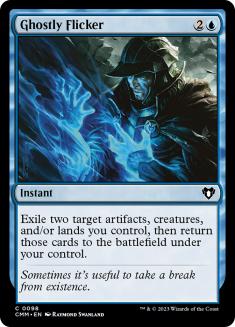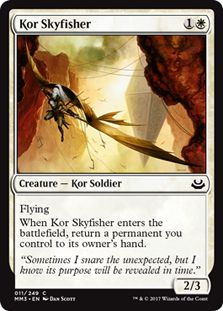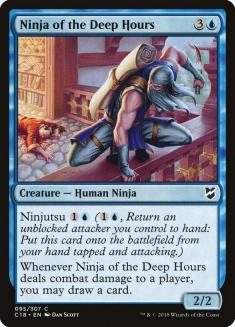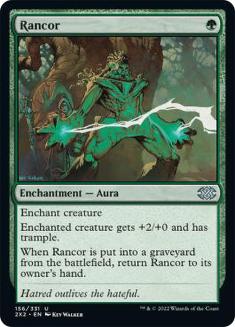Long live Pauper!
Thanks to everyone who chimed in on my last offering. I was quite happy with how the article turned out and even happier to discover that it resonated with some of you. Before we get started with today’s topic, I thought I’d call attention to some of your excellent bits of insight!
Your Thoughts From Last Time
As you many of you know, my last article attempted to identify the nature of playingfair versus doing something distinctly unfair within the context of Pauper. Here are some of your thoughts on the subject:
"Simplest way to define unfair: you are doing something unfair when it is impossible (or extraordinarily difficult) for your opponent to interact with or interrupt your ability to win the game." –Frank Bruzzese
"Fair and unfair are format relative . . . the relative fairness (or unfairness) varies dramatically between them . . . Is fair good? Can good be fair? When does really good start to become unfair?" –Zachary Thorp
"I took a four-color Zoo deck into a Pauper practice today and burned my opponent out from fifteen life with triple Tribal Flames. That card is pretty unfair . . . " –Don Thiebaut
Notions of fair and unfair will play a small part in today’s discussion, and I would not at all be surprised to see them revisited at some point in this column.
With that said, I think it’s time to dive into our new topic. Let’s get things underway!
Powerful Deck Attributes
"Powerful" is a term that gets thrown around a lot, yet it happens to be both relative and deceptively troublesome to define. While my objective today isn’t necessarily to pinpoint a Pauper definition of the word, I don’t think it would hurt at all to explore what it means to be powerful in this format.
Fortunately for us, a valuable article was written on the subject over on Daily MTG (courtesy of game designer Sam Stoddard). You can check out this article by clicking right here.
Here is a bit of what Stoddard had to say about the term "powerful" as it pertains to Constructed environments:
"Power in Constructed is most found in synergies and efficiency . . . What you want to happen in Constructed is to play as many cards as possible that when added up lead to a deck that can do really amazing things . . . "
To build upon this, I think it’s also important to be playing cards that don’t need to be added up to do something useful. In other words, synergy can’t be everything (since we won’t always have access to all of our synergistic pieces at the same time). At the end of the day, something that is powerful will likely need to be answered by our opponent in a timely fashion and can similarly win us the game if it isn’t answered.
I found this quote by Stoddard to be particularly compelling for us Pauper fans:
"While we are very happy to see that the cards we have printed have had a real impact on Legacy in the last year, it is hard to print cards that are able to stand up to a card pool that size."
Stoddard’s comment here can be extrapolated to the Pauper format, though recent printings have shaken up the environment from time to time (Gray Merchant of Asphodel, Nivix Cyclops, Electrickery, etc.). For those interested in a more transitional format where new cards are heavily featured, there is always Standard Pauper to consider (though that format offers up a relatively narrow list of options).
I’m not going to harp too much on definitions this time around, as I’d much rather move on to the attributes that can make a Pauper deck powerful. Our first one is quite a doozie, so here goes!
Repurchasing
"Repurchasing" could easily be called something else (perhaps "recycling" or some other "re" word). For all intents and purposes, repurchasing is the ability to garner additional utility from a previously harvested resource. This often occurs when permanents are bounced back to their controller’s hand or "blinked" (exiled and then returned to the battlefield). If you want to think in broad terms, you could consider repurchasing merely as a distinct avenue for gaining card advantage.
Repurchasing is a critical component of several Pauper decks because it allows them to win "the war" (previously explored in this article) on various fronts. It is an attrition-based trump, contributing to advantages that will turn the tide of a game gradually rather than abruptly.
Here are some of the format’s most celebrated repurchasing enablers:
To be sure there are many other enablers, but these ones see a significant amount of play. Of the four, I’d like to highlight Kor Skyfisher specifically. Skyfisher sees action in many different decks, most recently in the Pauper equivalent of Domain Zoo:
Creatures (18)
Lands (9)
Spells (33)
- 2 Rancor
- 2 Brainstorm
- 4 Lightning Bolt
- 8 Forest
- 1 Plains
- 1 Mountain
- 1 Island
- 2 Unearth
- 4 Tribal Flames
- 4 Abundant Growth
- 4 Nylea's Presence
Sideboard

Nylea’s Presence is certainly being felt in Pauper right now. I thought it would be fitting to highlight this deck since the unbanning of Wild Nacatl could have an impact on the imminent Pro Tour. The superior (when "turned on") creature size of Aura Gnarlid, Matca Rioters, and Nacatl along with the domain-enhanced reach of Tribal Flames echoes (softly) the approach that Affinity takes, and both utilize color fixing that is capable of replacing itself.
This is where Kor Skyfisher comes in. The prime targets for its enters the battlefield ability are the four Abundant Growths and four copies of Nylea’s Presence. Out of the sideboard, Lone Missionary can also be bounced to get the Zoo pilot out of burn range.
While I’d like to write more in depth about Domain Zoo at a later date, I think we should look at some other ways that repurchasing is exploited in our format:
Creatures (14)
Lands (16)
Spells (30)

One of the central ideas behind this deck is to have "extra" copies of Kor Skyfisher. These take the form of Boros Garrison and Glint Hawk, which multiply the value garnered from Ichor Wellspring, Kabira Crossroads, and Prophetic Prism. While all of this is effective when it comes to the attrition game, it doesn’t typify the most abusable purchasing in Pauper. The next deck however might:
Creatures (20)
- 4 Cloud of Faeries
- 4 Sunscape Familiar
- 2 Nightscape Familiar
- 4 Mulldrifter
- 1 Spellstutter Sprite
- 2 Mnemonic Wall
- 3 Sea Gate Oracle
Lands (16)
Spells (24)
- 1 Plains
- 4 Island
- 1 Capsize
- 1 Reaping the Graves
- 4 Snap
- 4 Compulsive Research
- 2 Foresee
- 4 Preordain
- 3 Ghostly Flicker
Sideboard

I like how Capsize has been incorporated into this deck to fill the void left behind by Temporal Fissure. Esper Familiar "goes off" by combining Cloud of Faeries, Ghostly Flicker, Karoo lands, and Mnemonic Wall. This has the potential to generate infinite mana for infinite Flickers and potentially infinite Capsizes.
Interestingly enough, Sage’s Row Denizen (a previous win condition in Esper Familiar) has been omitted from this Esper list. That’s not to say this deck can’t still mill opponents to death (it can), but doing so requires multiple Mnemonic Walls on the table so that the Familiar pilot can recur both Flicker and Compulsive Research incessantly.
Another deck capable of infinite repurchasing is this 61-card Dimir Teachings list, which took down a recent Pauper Premier Event:
Creatures (14)
Lands (19)
Spells (28)
- 2 Counterspell
- 4 Diabolic Edict
- 1 Exclude
- 5 Island
- 1 Serrated Arrows
- 1 Grim Harvest
- 3 Mystical Teachings
- 2 Agony Warp
- 1 Soul Manipulation
- 4 Doom Blade
- 2 Disfigure
- 1 Dead Weight
- 1 Ghostly Flicker
Sideboard

There’s a reason that Dimir Teachings and Esper Familiar are both running Mulldrifter—it’s one of the better Ghostly Flicker targets available to us Pauper mages. This deck also has access to Chittering Rats, which can eternally lock enemies out of a fresh draw step with Wall on the table and Flicker in hand.
Repurchasing takes many forms and plays an integral (though at times understated) part when it comes to winning games of Pauper.
Our next attribute is an obvious one but should by no means be undervalued.
Evasion
What I like about evasion in Pauper is the fact that it doesn’t just mean flying. This next deck should illustrate my point fairly well.
Creatures (28)
Spells (32)
Sideboard

None of the creatures here actually fly, but they might as well. In some ways Silhana Ledgewalker’s ability is better than flying (since it circumvents reach). For a deck like Mono-Green Stompy, evasion is a means of compensating for its lack of direct damage (this is partially why Vault Skirge, while not a green creature, sees a bit of play in this strategy). Aside from Ledgewalker, River Boa and Skarrgan Pit-Skulk also have situational evasion (which contributes to them being two of the deck’s most annoying creatures to deal with).
Evasion is an important attribute of the following deck, whose strategy I focused on in a previous article:
Creatures (12)
Lands (10)
Spells (38)
- 4 Lightning Bolt
- 2 Mountain
- 5 Island
- 1 Electrostatic Bolt
- 3 Shadow Rift
- 2 Piracy Charm
- 4 Ponder
- 2 Dispel
- 4 Preordain
- 3 Assault Strobe
- 4 Apostle's Blessing
- 4 Gitaxian Probe
Sideboard

Here we can observe evasion in the form of Apostle’s Blessing, Delver of Secrets, and Shadow Rift. Being able to dodge blockers (sometimes artfully) is often all it takes for these explosive creatures to connect for lethal.
It’s probably not necessary for me to explain why evasion is good, but I will say that it’s quite a difference maker. When boards are stalled out or we need just a few points of damage to wrap things up, evasion can be one of the most important attributes of all.
This brings us to today’s final attribute, which I’ve decided to call:
Frugality
Frugality just generally means cheap stuff. You’ll find that the majority of Pauper decks have either a sufficient number of turn 1 plays or ways to "cheat" on mana by making spells cheaper or doing things for free. I don’t really need to post a decklist to support this idea because many of the lists posted above already do! Sunscape Familiar and Nightscape Familiar from the Esper deck are prime examples, as is Cloud of Faeries (which can untap a pair of Karoos for a net of six mana). In the Mono-Green Stompy list, Gather Courage is as close to free as we can get (thanks Nettle Sentinel!), and Quirion Ranger does quite a bit of cheating in her spare time.
Since I discussed doing things for free in our last article, I’ll spare you the rehashing of ideas. Needless to say, Pauper is a cheap format in more ways than one!
Your Turn
What other powerful deck attributes should be taken into Pauper consideration? Let me know which attributes I missed and potentially which ones I got wrong. Let’s get the discussion going!




